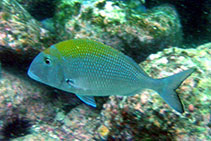| Family: |
Sparidae (Porgies) |
| Max. size: |
37 cm TL (male/unsexed) |
| Environment: |
reef-associated; marine; depth range 0 - 85 m |
| Distribution: |
Western Atlantic: Bahamas to Brazil, including the southern part of the Gulf of Mexico and throughout the Caribbean Sea. |
| Diagnosis: |
Dorsal spines (total): 12-12; Dorsal soft rays (total): 12-12; Anal spines: 3-3; Anal soft rays: 10-10. Dorsal profile of head moderately steep; prefrontal tubercle not well developed; silvery with a lavender iridescence, the edges of the scales brownish yellow and the centers with a vertically elongate iridescent blue-green or blue spot (Ref. 13442). |
| Biology: |
Adults often seen over rocky areas or reefs, but also on flat bottoms to about 85 m depth, while the young inhabit shallower waters (Ref. 3815). Feeds on crabs, mollusks, worms, brittle stars and hermit crabs (Ref. 3815). This is the most common species of the genus in the Antilles (Ref. 3815). Important food fish (Ref. 3815). |
| IUCN Red List Status: |
Least Concern (LC); Date assessed: 30 March 2011 Ref. (130435)
|
| Threat to humans: |
reports of ciguatera poisoning |
Source and more info: www.fishbase.org. For personal, classroom, and other internal use only. Not for publication.

